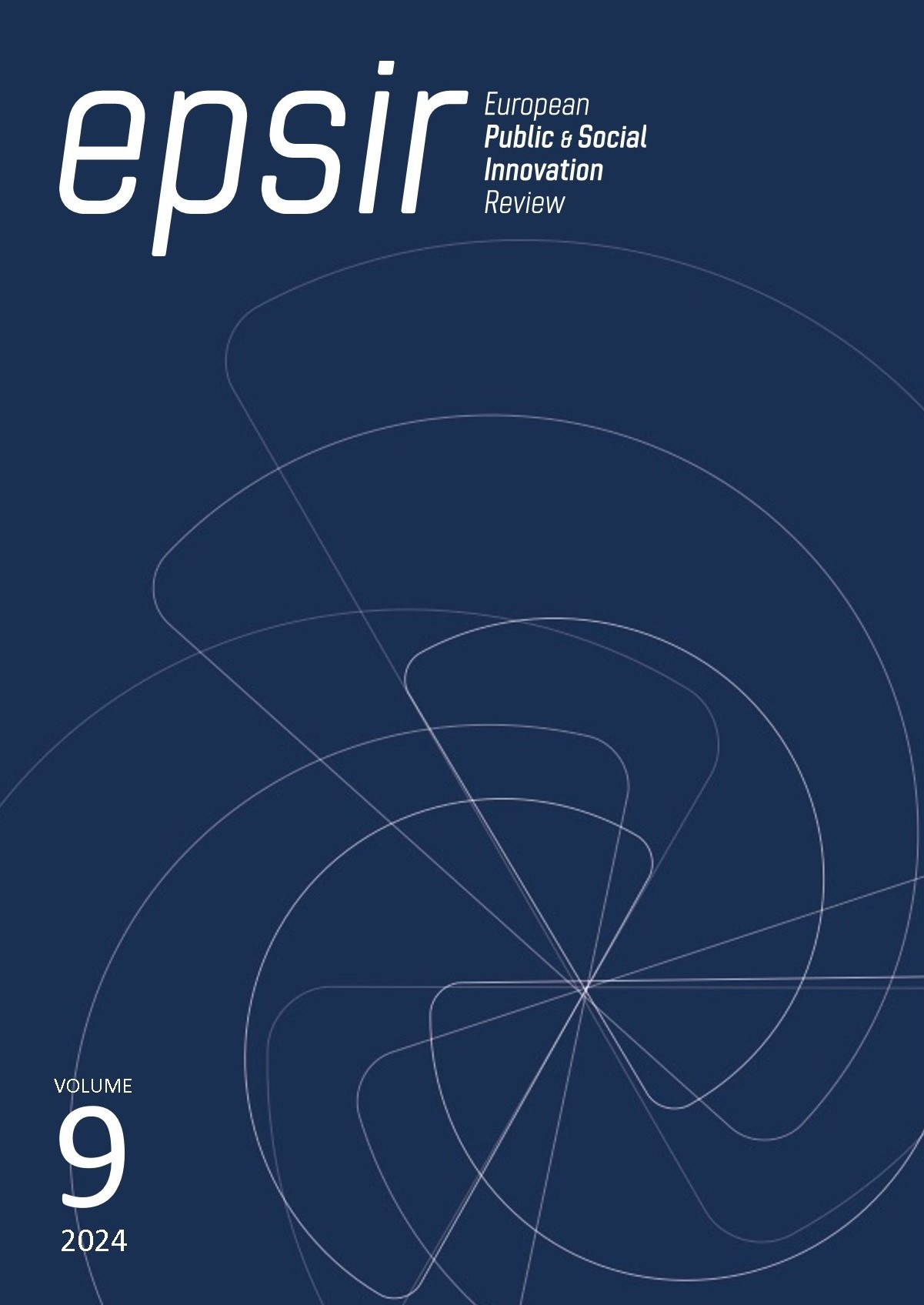Comunicación en zonas despobladas: Revisión sistemática de la literatura
DOI:
https://doi.org/10.31637/epsir-2024-1815Parole chiave:
inclusión digital, accesibilidad, desarrollo rural, conectividad, comunicación comunitaria, ciencias de la comunicación, población, inclusividadAbstract
Introducción: Los estudios previos sobre la comunicación en zonas despobladas atestiguan la complejidad de las barreras y desafíos que la población de los entornos difíciles de acceso enfrenta para el intercambio de información. La revisión de la literatura proporciona abundantes pruebas del hecho de que los enfoques teóricos tradicionales son insuficientes para abordar las necesidades de estas comunidades y, por lo tanto, parecen requerir cierta preconcepción. Metodología: Por lo que respecta a la estructura, se trata de una revisión sistemática de la literatura sobre la comunicación en zonas despobladas desde 2018 hasta 2023. Objetivo: El objetivo general es identificar las líneas de trabajo más claramente definidas por la literatura del campo mediante la revisión de los postulados teóricos, los problemas abordados, las conclusiones y recomendaciones formuladas en los estudios encontrados. La metodología está relacionada con el protocolo PRISMA porque exige un proceso exigente para seleccionar y evaluar fuentes y mantener la calidad y vigencia de las fuentes seleccionadas. Conclusiones: A partir de los resultados, se identificaron brechas importantes en la teoría de la comunicación en zonas despobladas y demanda por más y más políticas adecuadas para garantizar la inclusión y la eficiencia. En cuanto a las recomendaciones generales, hay espacio para adaptar las estrategias comunicativas a la realidad de las zonas despobladas y proponer políticas académicas e investigaciones en el área.
Downloads
Riferimenti bibliografici
Cruz, S. y Arévalo, D. (2023). Desarrollo comunitario y redes de comunicación en zonas de baja densidad. Community Networking Journal, 14(2), 98-114. https://doi.org/10.1090/1010700987
Fernández, J. y Morales, R. (2020). Comunicación intercultural y barreras tecnológicas en áreas rurales. Journal of Intercultural Communication, 10(5), 75-92. https://doi.org/10.1177/2042753X2041654
Freire, P. (2005). Pedagogía del oprimido. Siglo XXI Editores.
García, L. y Torres, M. (2019). Comunicación y desarrollo rural en zonas aisladas: Estudios de caso en América Latina. Editorial Universidad Andina.
Gómez, M. y Álvarez, R. (2021). Capacitación digital y desarrollo rural: Perspectivas y desafíos. Journal of Digital Inclusion, 14(3), 58-76. https://doi.org/10.1177/2062753X2141987
Herrera, P. y Gómez, L. (2022). Impacto de la comunicación inclusiva en el desarrollo comunitario rural. Journal of Community Development, 15(4), 178-194. https://doi.org/10.1080/1407065X2022.205392 DOI: https://doi.org/10.53641/junta.v4i1.65
Hernández, J., Martínez, S. y López, F. (2019). Inclusión digital en comunidades rurales: Desafíos y oportunidades. Revista Internacional de Comunicación Digital, 12(3), 45-63. https://doi.org/10.1007/s11070-019-0123-7
Hernández, R. y León, G. (2022). Barreras y oportunidades en la comunicación rural: Un análisis desde la perspectiva de los habitantes locales. Rural Studies, 12(4), 43-65. https://doi.org/10.1080/13658816.2022.201210
Martínez, A. (2021). Comunicación para el desarrollo: Teoría y práctica en zonas rurales. Editorial Pontificia.
Martínez, A. y Soto, R. (2023). Innovación social en la comunicación rural: Nuevas perspectivas para el desarrollo sostenible. Journal of Rural Studies, 32(2), 78-95. https://doi.org/10.1016/j.jrurstud.2023.01.014 DOI: https://doi.org/10.1016/j.jrurstud.2023.01.014
Moreno, L. y Salazar, T. (2020). Sostenibilidad y comunicación en áreas despobladas: Modelos y prácticas efectivas. Rural Communication Review, 9(3), 123-143. https://doi.org/10.1177/1102753X20949217
Pérez, E., López, J. y Ramírez, P. (2020). Infraestructura y comunicación en zonas despobladas: Retos y posibilidades. Comunicación y Sociedad, 7(4), 112-134. https://doi.org/10.1177/0961463X20930356
Pérez, R. y Chávez, M. (2020). El rol de la comunidad en la comunicación rural: Un estudio de caso en el Perú. Revista de Comunicación Rural, 8(3), 124-145. https://doi.org/10.1080/13658816.2020.1823912
Ramírez, F. y Soto, A. (2023). Infraestructura digital en zonas rurales y su impacto en la comunicación comunitaria. Communication Studies, 40(2), 99-117. https://doi.org/10.1080/01900692.2023.1975105
Ramírez, P. y López, G. (2022). Desafíos de la comunicación intercultural en entornos rurales. International Journal of Intercultural Relations, 46(1), 98-112. https://doi.org/10.1080/01471772.2022.2021941
Rogers, E. M. (2003). Diffusion of innovations (5th ed.). Free Press.
Rojas, M. y Delgado, P. (2023). Evaluación de políticas de comunicación inclusiva en zonas rurales. Policy Studies Journal, 30(1), 57-73. https://doi.org/10.1080/10506030.2023.2120194
Sánchez, F. y Rodríguez, C. (2022). Colaboración público-privada en la mejora de la comunicación rural: Un estudio comparativo. Comparative Rural Communication Journal, 18(3), 99-120. https://doi.org/10.1007/s11077009703
Smith, H. y Johnson, L. (2018). Resiliencia comunicativa en zonas rurales: Estrategias y enfoques colaborativos. Rural Communication Journal, 15(2), 33-52. https://doi.org/10.1177/2042753X18792047
Soto, L. y Mendoza, T. (2021). Conectividad y comunicación participativa en zonas rurales despobladas: Un análisis de caso en América Latina. Journal of Communication for Development, 9(1), 89-105. https://doi.org/10.1080/13504630.2021.1957103
Downloads
Pubblicato
Come citare
Fascicolo
Sezione
Licenza
Copyright (c) 2024 Ángel Johel Centurión Larrea

Questo lavoro è fornito con la licenza Creative Commons Attribuzione - Non commerciale - Non opere derivate 4.0 Internazionale.
Authors who publish with this journal agree to the following terms:- Authors retain copyright and grant the journal right of first publication with the work simultaneously licensed under Creative Commons Non Commercial, No Derivatives Attribution 4.0. International (CC BY-NC-ND 4.0.), that allows others to share the work with an acknowledgement of the work's authorship and initial publication in this journal.
- Authors are able to enter into separate, additional contractual arrangements for the non-exclusive distribution of the journal's published version of the work (e.g., post it to an institutional repository or publish it in a book), with an acknowledgement of its initial publication in this journal.
- Authors are permitted and encouraged to post their work online (e.g., in institutional repositories or on their website) prior to and during the submission process, as it can lead to productive exchanges, as well as earlier and greater citation of published work (See The Effect of Open Access).




